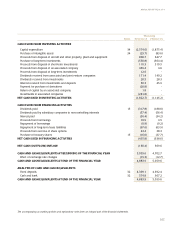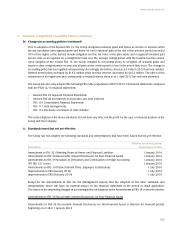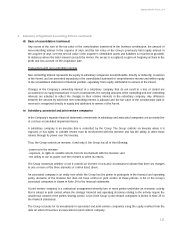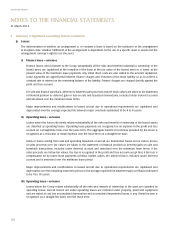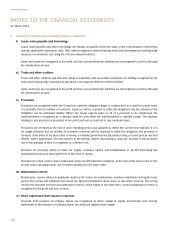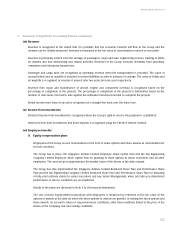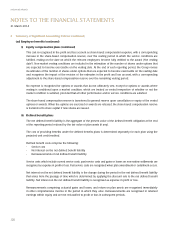Singapore Airlines 2014 Annual Report Download - page 118
Download and view the complete annual report
Please find page 118 of the 2014 Singapore Airlines annual report below. You can navigate through the pages in the report by either clicking on the pages listed below, or by using the keyword search tool below to find specific information within the annual report.
116
NOTES TO THE FINANCIAL STATEMENTS
31 March 2014
SINGAPORE AIRLINES
2 Summary of Significant Accounting Policies (continued)
(j) Leases
The determination of whether an arrangement is, or contains a lease is based on the substance of the arrangement
at inception date: whether fulfillment of the arrangement is dependent on the use of a specific asset or assets and the
arrangement conveys a right to use the asset.
(i) Finance lease – as lessee
Finance leases, which transfer to the Group substantially all the risks and benefits incidental to ownership of the
leased asset, are capitalised at the inception of the lease at the fair value of the leased asset or, if lower, at the
present value of the minimum lease payments. Any initial direct costs are also added to the amount capitalised.
Lease payments are apportioned between finance charges and reduction of the lease liability so as to achieve a
constant rate of interest on the remaining balance of the liability. Finance charges are charged directly against the
profit and loss account.
For sale and finance leaseback, differences between sales proceeds and net book values are taken to the statement
of financial position as deferred gain or loss on sale and leaseback transactions, included under deferred account
and amortised over the minimum lease terms.
Major improvements and modifications to leased aircraft due to operational requirements are capitalised and
depreciated over the average expected life between major overhauls (estimated to be 4 to 8 years).
(ii) Operating lease – as lessee
Leases where the lessor effectively retains substantially all the risks and benefits of ownership of the leased assets
are classified as operating leases. Operating lease payments are recognised as an expense in the profit and loss
account on a straight-line basis over the lease term. The aggregate benefit of incentives provided by the lessor is
recognised as a reduction of rental expense over the lease term on a straight-line basis.
Gains or losses arising from sale and operating leaseback of aircraft are determined based on fair values. Excess
of sales proceeds over fair values are taken to the statement of financial position as deferred gain on sale and
leaseback transactions, included under deferred account and amortised over the minimum lease terms. If the
sales proceeds are below fair values, the loss is recognised in the profit and loss account except that, if the loss is
compensated for by future lease payments at below market values, the deferred loss is included under deferred
account and is amortised over the minimum lease period.
Major improvements and modifications to leased aircraft due to operational requirements are capitalised and
depreciated over the remaining lease term period or the average expected life between major overhauls (estimated
to be 4 to 10 years).
(iii) Operating lease – as lessor
Leases where the Group retains substantially all the risks and rewards of ownership of the asset are classified as
operating leases. Aircraft leased out under operating leases are included under property, plant and equipment
and are stated at cost less accumulated depreciation and accumulated impairment losses, if any. Rental income is
recognised on a straight-line basis over the lease term.



